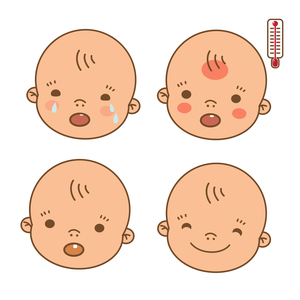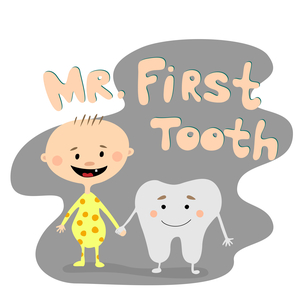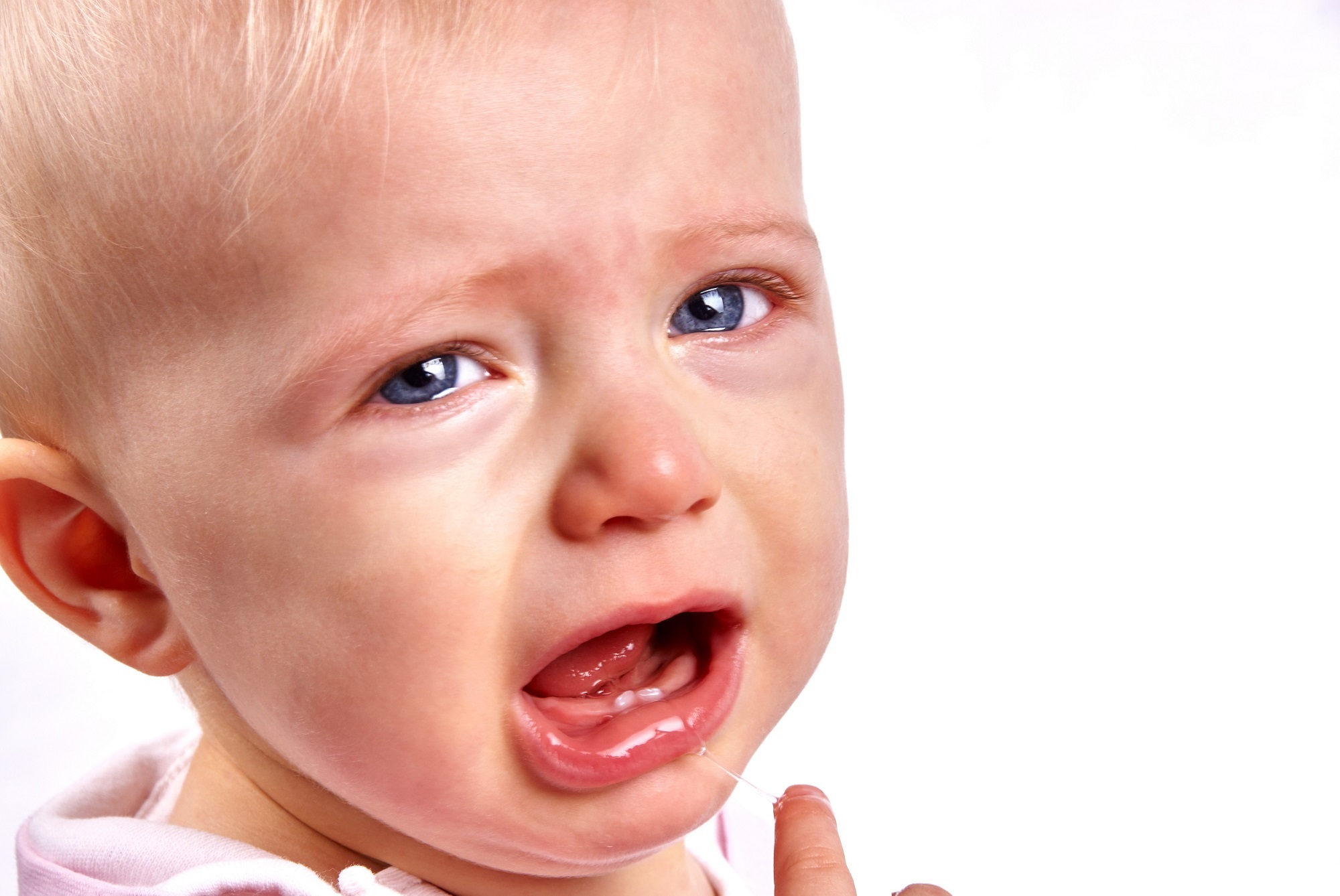From time to time, your baby will enter a difficult stage. When parents successfully overcome the challenges of early infancy, colic, and growth spurt, they will have to face teething. How can you help your irritated baby?
Usually, teething begins when babies are between 5 to 10 months old (a month later for premature babies). But there are children who get their first teeth just before they are one year old – it’s nothing to worry about. Teething is largely genetic. Perhaps ask the grandmothers if they remember when the parents of the baby got their first teeth. It’s quite possible that your baby will be the same. If a one-year-old baby still doesn’t show signs of teething, consult a paediatric dentist.
Born with teeth
Sometimes teeth appear much earlier. Very rarely, a newborn child arrives with a tooth or teeth, or a tooth cuts even a month after the birth. If that’s the case, check the baby’s mouth carefully and see whether the tooth moves, if it’s not causing any threat to the baby or does in not hamper breastfeeding.
Salivating
A lot of parents wonder if teething may begin in the 3rd month. That’s when the baby begins to dribble, sucking fingers, and biting toys. Usually, these are not the symptoms of teething. There is so much saliva in the little mouth that the baby isn’t able to swallow all of it and may cough or try to clear their throat. A wet chin, wet clothes… It’s a good idea to apply protective cream around the lips and put a soft bib on. Does baby explore different objects with their mouth? That’s great! It means they are developing well – make sure their toys, such as flexible rings and light rattles, are clean and safe to use.
It’s the gums’ fault
When salivating and biting everything within reach is accompanied by the softening of the gums, it means you can expect teething. Usually, the baby becomes irritated, anxious, and wakes up more often. They may also lose their appetite. Sometimes, while biting a toy the baby freezes, cringes and begins to cry – it means it’s just hurt their delicate and sore gums.
Check the mouth, see how the gums look like and clean them gently. If under the mucous membrane you can see a bluish tinge, you’d better ask your paediatrician about it because it may mean a haematoma.

Weakened immunity
If white patches appear on the baby’s tongue, palate, lips or gums, consult with your paediatrician immediately. Most likely it is a thrush and it requires treatment of both mom and the baby if you are breastfeeding. It is caused by yeast fungus (Candida), which “likes” to attack infants with lowered immunity. Moreover, six-month-old babies are no longer protected by the antibodies they acquired during pregnancy, whereas their own immune system is not yet strong enough. Softened mucous membrane and putting not always clean, objects into the mouth can significantly increase infection risk.
Difficult period
In theory, teething doesn’t take long – several days of an irritated, clingy baby and the little white spot should appear in the mouth. But in reality, it varies. Sometimes it’s clear that a baby is teething, then the symptoms go away, only to return some time later. Meanwhile the parents rack their brains whether the fussiness is a result of teething or if there is another reason. In fact, it easy to make misjudge, mainly because the teething can be accompanied by a mild fever, lack of appetite, stuffy nose, upper respiratory tract infection or light diarrhoea. And, of course, loads of unhappiness: from frequent crying to sleepless nights.
How can you survive this?
Below you’ll find a number of proven methods that help you and the baby survive the teething phase:
Massages Sore and itchy gums can be gently massaged with a clean finger wrapped with a moist gauze pad. For moistening use boiled, cooled down water or a cold chamomile or marigold infusion. You can also use a dedicated silicon finger toothbrush looking like a soft, studded thimble. Clean it thoroughly or scalded out after use.
Teething rings. Some children feel better when they chew on a gel teething rings cooled down in a fridge (not a freezer!). Others prefer soft, rubber chewing toys, or just chew a towel or a muslin square.
Soothing gel Apply a thin layer of teething gel to the gums before feeding and sleeping. Just be careful not to overdose.
Closeness The anxious baby needs their parents, their patience, hugs, familiar scent.
White noise Like in many other situations when the baby is anxious and can’t sleep, Whisbear the Humming Bear may help. The soothing white noise produced by that sleep aid reminds the baby of the sounds they heard in their mother’s womb. A CrySensor-equipped bear may be useful when the baby has problems sleeping and easily wakes up.
Spoon feeding If sore gums make breastfeeding difficult for the baby, express the breastmilk (manually or with a breast pump) and feed the baby with a soft, silicone spoon.
Cool pulp An older baby who has already started solids can be fed with blended food or soft baby cereals, best served cold.
Painkillers If your baby suffers really badly during teething, they can’t fall asleep or keep waking up, when they’re tired, fussy, sore, with the temperature, you can use a paracetamol-based painkiller or an anti-inflammatory one (with ibuprofen).

A set of milk teeth
The teething period does not only mean the time when we await the very first teeth – usually the lower incisors. The process ends with 20 milk teeth in the baby’s mouth. Usually upper and lower medial incisors cut first, followed by the lateral incisors, premolars, canines and finally molars. However, this order and the accompanying symptoms may vary. There are children whose incisors go through the gums almost painlessly and only when molars, teeth with a large area of the crown starts cutting through their life become a misery. We can use the same methods to alleviate pain and anxiety throughout the entire teething period. Usually, all milk teeth are in place within the first 30 months.
Oh I’m brushing my teeth on top, it’s so much fun I hate to stop
It’s very important to take care of teeth even if the first tooth looks more like a rice grain than a real tooth. Clean the milk teeth after meals and especially before sleeping, when there is less saliva produced and the teeth are not rinsed so often. First use a clean, moist cloth, then gently brush with a soft toothbrush suitable for babies. Use special low-fluoride toothpastes dedicated for infants and little children. Such a small baby doesn’t know yet how to spit the paste out, so after brushing remove the paste with a clean damp cloth.
Sipping sweet drinks, drinking from the bottle or excessive sweets consumption significantly increase the risk of tooth decay. You should really avoid these, but if you do allow your baby a little bit of sugary snacks, always brush the teeth afterwards. After all – healthy milk teeth mean healthy permanent teeth.
And one more thing: protect your children from your own bacteria. Don’t lick your child’s cutlery or soothers, don’t drink from the same cup. The cavity-causing bacteria is usually a “gift” from parents or the family.













